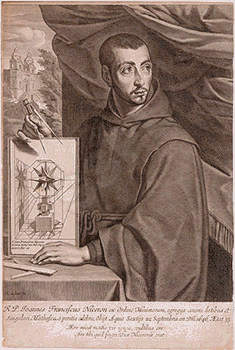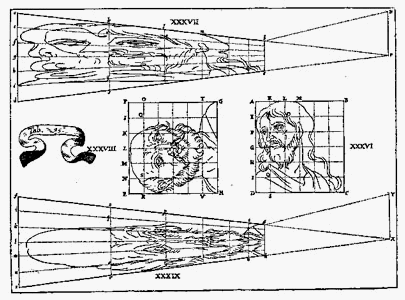|
|
|
|
|
|
|
|
|
|
|
|
|
|
|
|
|
|
|
|
| NICERON, Jean-Francois
|
| La perspective curieuse .. avec l'Optique et la catoptrique du RP Mersenne
|
| Paris: Langlois ,1652
|
| Folio (350 x 225 mm), [12], 191, [I]; [12], 134, [2 (blank) pp], frontispiece, portrait, 50 numbered plates.
|
| French armorial calf binding with the (later) gilt arms of Joseph Bonnier de la Mosson (1702 - 1744) on the front cover and his monogram on the rear cover.
|
|
|
|
|
|
|
|
|
|
|
|
|
|
Geometrical perspective was studied intensively during the 16th and 17th century
for both its mathematical and its artistic applications. One particularly contentious
issue was the role of the observer's position in the rendering of realistic 3D imagery
in a 2D picture. The general practice was to develop the perspective from an
observation point normal (i.e., perpendicular) to the image plane. However, some
artists (notably Hans Holbein) and mathematicians were experimenting with a form
of perspective known as anamorphic projection, in which the 2D scene is rendered
so that, from a normal point of view it appears grotesquely distorted, but becomes
realistic when viewed from an extremely oblique angle. Jean-Francois Niceron was
a French mathematician who made significant contributions to mathematical and
artistic perspective, especially in the areas of anamorphic projection and optical
illusion. The Perspective curieuse is one of the most important 17th century
books on this subject. He and Emmanuel Maignan painted a pair of anamorphic
murals on either side of a gallery at the Minim convent of Santa Trinita dei Monti in Rome.
When viewed nearly edge on, the murals appear to jump out in front of the viewer.
|


